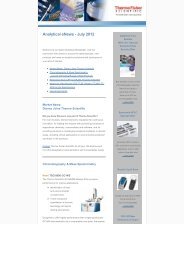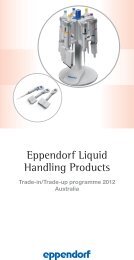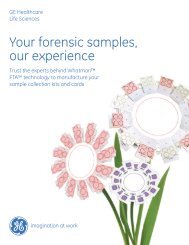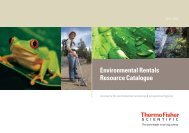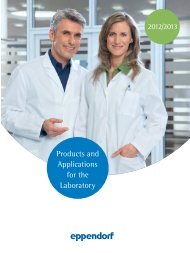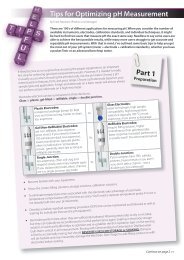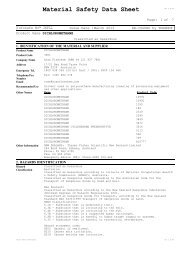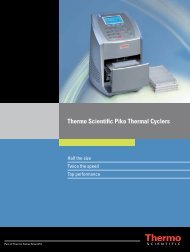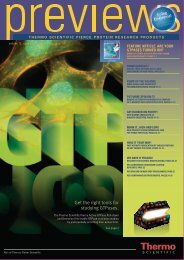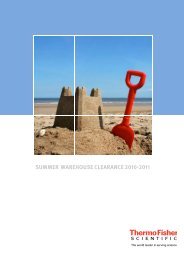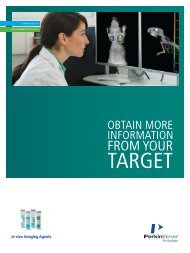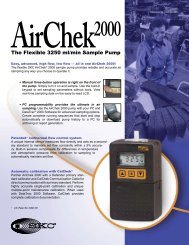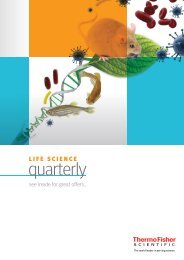Issue 1 - Thermo Fisher
Issue 1 - Thermo Fisher
Issue 1 - Thermo Fisher
Create successful ePaper yourself
Turn your PDF publications into a flip-book with our unique Google optimized e-Paper software.
Feature article<br />
Stem Cell Promise–<br />
Research Brings Autograft Revolution Closer<br />
Stem cells have shown the<br />
promise to revolutionise the<br />
treatment of many diseases,<br />
as noted by George Wolff in his book ‘The Biotech<br />
Investor’s Bible’: “... The damaged brains of Alzheimer’s<br />
disease patients may be restored. Severed spinal cords<br />
may be rejoined. Damaged organs may be rebuilt. Stem<br />
cells provide hope that this dream will become a reality.”<br />
Professor Anthony Hollander, the ARC Professor of<br />
Rheumatology & Tissue Engineering in the Department<br />
of Cellular & Molecular Medicine at the University of<br />
Bristol, UK, is in the vanguard of this groundbreaking<br />
research area. His group has perfected stem cell culture<br />
protocols that provide the consistent starting material<br />
essential for all areas of their bioengineering research.<br />
Furthermore, their knowledge and facilities were<br />
instrumental in the first ever bioengineered tracheal graft.<br />
Stem cells show therapeutic potential<br />
For Professor Hollander and his colleagues, stem cells<br />
provide the basis for their tissue engineering research.<br />
Much has been written and discussed on embryonic<br />
stem cells, but for Professor Hollander’s group, the<br />
main focus has been on adult (somatic) stem cells.<br />
Prof Hollander commented, “Embryonic stem cells do<br />
have the potential to become every type of cell in the<br />
body, but they are very difficult to control fully – they<br />
form tumours relatively easily. Somatic stem cells do not<br />
possess the same breadth of differentiation capabilities<br />
as embryonic stem cells, but are more predictable and<br />
controllable.” Importantly, somatic stem cells are found<br />
in a number of locations, such as the bone marrow,<br />
and can therefore be retrieved directly from patients.<br />
This means that it is possible for grafts to be grown from<br />
these cells and then reimplanted in the same patient – so<br />
called autologous grafts. This removes the need for<br />
immunosuppressive therapies to prevent rejection,<br />
thereby greatly increasing the chance of grafting success.<br />
Research provides foundation for tissue replacement<br />
Bone marrow mesenchymal stem cells (BMSCs)<br />
harvested from the heads of femur bones are the major<br />
source of stem cells in Professor Hollander’s lab. Dr Sally<br />
Dickinson, a research associate in the group explained,<br />
“Bone marrow mesenchymal stem cells are donated<br />
by patients undergoing hip replacement operations<br />
and are the perfect starting point for our research, as<br />
they are multipotent and can therefore form the major<br />
cell types involved in rheumatology applications.” The<br />
donated cells are suspended in a specialised stem cell<br />
culture medium formulated to promote the growth<br />
and differentiation of BMSCs. To remove any bone<br />
remnants, the cells are washed several times in the<br />
medium and fat is then removed by gently centrifuging<br />
the cells at 1500 RPM for 5 min and recovering the<br />
cell pellet. Once the cells are clean and free from bone<br />
or fat, they are seeded in 175 cm2 culture flasks at a<br />
density of 5-10 million cells. The cells are then placed in<br />
a CO2 incubator (5% CO2, 37 ºC, 95% Humidity), with<br />
media changes after four days and then every other day<br />
until adherent cells have reached 90% confluence.<br />
Differentiation<br />
Once successfully expanded, the BMSCs are further<br />
incubated in specially developed media to enable<br />
differentiation into either chondrogenic monolayers,<br />
osteogenic or adipogenic cultures. Alternatively,<br />
BMSCs can be added to polyglycolic acid (PGA)<br />
scaffolds and incubated for five weeks with regular<br />
media changes to create three-dimensional engineered<br />
cartilage. The majority of research work conducted<br />
in Prof Hollander’s lab focuses on chondrogenic<br />
cultures, either monolayer or 3D, as these are the most<br />
important cell type for osteoarthritis applications.<br />
Analysis<br />
Several analytical techniques are used to assess BMSC<br />
cultures and their differentiation, including histological<br />
staining and real-time PCR. However, the bulk of the<br />
analyses on the engineered cartilage are carried out using<br />
enzyme-linked immunosorbant assays (ELISAs), since<br />
they provide quantitative biochemical measurements<br />
for key molecules such as collagen types I and II. All<br />
ELISAs in Professor Hollander’s lab are analysed on<br />
a photometer.A range of laboratory instruments are<br />
used in the research, many of which are from the<br />
<strong>Thermo</strong> Scientific Stem Cell Excellence portfolio.*<br />
*Instruments used from this range include the <strong>Thermo</strong> Scientific Sorvall Legend RT-Plus centrifuge, the <strong>Thermo</strong> Scientific Cytoperm 2 CO 2<br />
Incubator, and the <strong>Thermo</strong> Scientific<br />
Multiskan microplate reader. At every manipulation stage, the cells were handled within a <strong>Thermo</strong> Scientific Herasafe KS12 Type 2 Class 2 biological safety cabinet.<br />
Cell culture research also requires a large amount of manual pipetting which – if not done properly – can lead to inconsistencies and possibly repetitive strain injuries for<br />
the user. In Prof Hollander’s lab, the group used <strong>Thermo</strong> Scientific Finnpipettes. Essential reagents, which contribute to the ongoing success of the lab, were stored in a<br />
<strong>Thermo</strong> Scientific Revco freezer, which provides ultra low temperature storage at -86ºC.<br />
20



